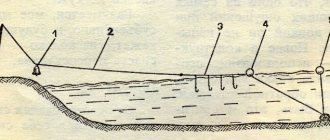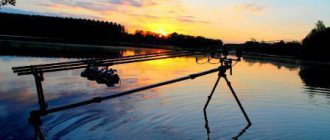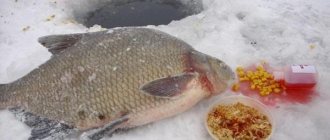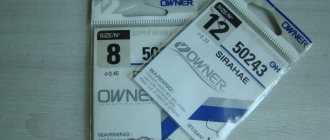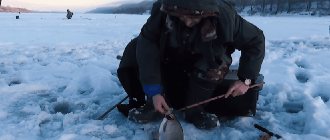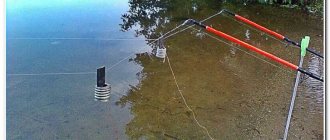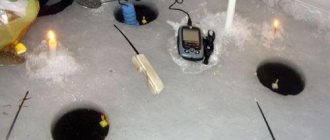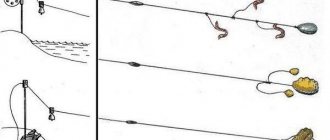ways to catch bream, one of them is with an elastic band. If you do everything correctly, a good catch is guaranteed. This is still the same bottom fishing, but with a rubber shock absorber. People call this type of tackle “rubber band”. Catching bream with an elastic band occurs mainly in reservoirs without a current. Usually they fish this way from the shore, but there are fishermen who fish with this gear from a boat. But in this article we will talk specifically about fishing from the shore. This tackle is ideal for bream. The thing is that bream, especially large ones, are very careful. And the elastic band has a very important advantage in comparison with other gear - quiet, accurate delivery, and, most importantly, to the desired pre-fed place. It is advisable to feed the place in the evening if you are going fishing in the morning of the next day. Even ordinary boiled peas can be used as bait.
What are the features of catching bream with an elastic band?
In itself, fishing for bream using a rubber band is a very simple method of catching this fish, but at the same time the efficiency of such bream fishing is very high. It is necessary to choose the correct fishing location using an elastic band, cast the gear correctly and wait for bream bites.
The equipment of such an elastic band is very simple; it differs in that all the components of such equipment are quite affordable for every angler. At the same time, the process of assembling such equipment does not take much time; this equipment can be easily assembled by both an experienced and experienced fisherman and a beginner in fishing. Among other things, fishing for bream using this method allows you to catch bream even in small thickets of aquatic algae and small vegetation.
Bream fishing in August
It is believed that if you catch bream at the end of summer, you can expect a good catch.
When looking for a fishing spot, there are a few things to consider:
- The habitat of bream is a deep layer of water, at the very bottom. One should not lose sight of the fact that this is a bottom-dwelling fish.
- This fish tries to avoid places where there is a strong current. Therefore, it is better to choose a place with calm water.
- At night, as well as in inclement weather, it may come closer to the shore than usual.
- Bream does not like a sandy bottom, but it may like a clayey and silty bottom.
- In August, closer to night, the bite gets better at night.
- In the daytime in bad weather the bite will be much better than in other cases.
What is included in the rubber band for bream?
Such equipment for catching bream, like an elastic band, is simple; it includes the following components:
- - hooks;
- — cargo;
- - fishing line;
- - you will need a reel;
- - you will also need several carabiners;
- - You definitely need the elastic band itself.
This gear is distinguished by its compactness, but at the same time it allows for the greatest coverage of the territory of the reservoir when catching bream. It should be noted that there is no need to constantly drag the tackle from place to place.
How to make an elastic band for catching bream yourself?
To make an elastic band for catching bream on your own, the fisherman should prepare in advance several hooks, a sinker, thirty meters of fishing line, about ten to twenty meters of elastic, and you will need a reel.
And then you should strictly follow the list of actions below:
- - you should take a nylon thread and string a sinker on it;
- - we knit this thread itself in a fishing line, securing it to a couple of strong knots;
- — we take a fishing line and attach it to an elastic band, and the fishing line needs to be taken three times more than the elastic band itself;
- - and it will be necessary to make the number of loops, how many leashes you will have on this tackle, approximately in
- every meter.
To make leashes, we take a fishing line, attach a hook to one end of it and hook the other end to a loop on the tackle. We attach all the tackle to the reel. The elastic band itself should be wound onto the reel very evenly.
Difficulties in installing gear
It is best to make this gear yourself; you should not rely on ready-made gear that is sold in stores.
First you need to prepare leashes with hooks. It is better if they are attached to the main fishing line through carabiners - this will facilitate installation and prevent the gear from getting tangled during transportation. You can, of course, neglect this by putting pieces of cambric or nipple rubber on the tip of the hooks.

Loops are made on the main line for attaching leashes at a distance of at least 30 cm from each other. In total, you need to make 5-7 such bends.
The shock absorber is tied to the main line through a swivel. This will protect the tackle from twisting. The weight is also attached to the rubber via a carabiner.
Fishing with an elastic band has the only drawback - the difficulty in calculating the gear. Here it is important to accurately select the length of the rubber itself and the weight of the load.
If the shock absorber is too short, it may break when the tackle is pulled up. When the length of the rubber is too long, there is a chance that it will not deliver the main line with the leads to the right place.
A load that is too heavy can also cause the rubber to break, and a light one will not hold the tackle.
To accurately calculate the length of the tackle, it is necessary to at least approximately determine its casting range. Next, taking into account the size of the main line, you need to determine the required footage of the shock absorber. Here it should be taken into account that 1 m of rubber at rest is equal to 3 m when it is stretched.
The weight of the load is also calculated based on the casting distance. To accurately select it, you must first lay out all the gear on the shore and try to pull it towards you until the last leash. The load must remain in its place.
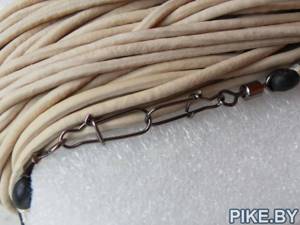
Fishing with a rubber band involves fishing at a considerable (from 30 to 70 m) distance from the shore. Considering the specific design of the “elastic band”, it is unlikely that a beginner will be able to cast it by hand, although some fishermen manage to do this using various devices. Here is an example of one of them.
Take an ordinary beer or coffee can. The pre-unwound tackle is wound onto it so that the rubber with the load is on top and the fishing line is on the bottom.
The end with the weight for casting is taken into the hand that is best able to throw it further. The can should be in the other hand extended forward.
When thrown, the weight with rubber flies forward, unwinding the fishing line on the can according to the principle of an inertia-free reel.
As a last resort, you can swim and install the “elastic band” in the right place. But it is best to deliver the gear using a boat - it is convenient and safe for the fisherman. Moreover, this method eliminates spontaneous tangling of the donkey.
The end of the fishing line is fixed to a peg pre-installed on the shore, about 60-80 cm high. At a distance of about 30 cm from the place where the tackle is fixed, a bell or an electronic bite alarm is hung.
When catching this fish, you need to remember that this fish is very shy. Any sharp sound can scare her. Therefore, a fisherman, going to catch it, must take into account this feature. Not only a loud sound (such as a knock), but also the ordinary sound of human steps can scare away fish.
Therefore, if you are counting on a good catch, try to behave as quietly and inconspicuously as possible.
This fish behaves differently at different times of the year. In warm summer time, it prefers fairly shallow depths. With the onset of cold weather the situation changes. At this time, bream prefers to be in the depths. If you focus on fishing in these areas, you can find quite a few schools of fish.
However, even at such a time, catching bream near the shore will not be a hopeless task. If you take care of generous bait, your chances of catching bream in such a place will increase dramatically. In addition, if you fish at night, you need to take into account certain habits of this fish.
At this time of day, bream, as a rule, leaves deep-water areas and goes hunting in shallower places.
Fishing for bream in August is a pleasure for experienced anglers. Let's figure out what's good about catching bream in August, where to catch bream, what lures and bait to use. Let's get acquainted with the method of catching bream using a feeder, a float rod, and also learn how to assemble a donka - an elastic band for catching bream. Use these tips in practice and fishing for bream in August will be effective.
Fishing in the last month of summer promises a good catch. It’s not hot anymore and the fish are feeding quite actively, preparing for the autumn cold.
Many anglers note that August is a good month for bream fishing. However, in order to boast of a good catch, you need to know where to catch bream in August, what gear and bait are needed.
Let's figure out how to make bream fishing in August effective. The first thing you need to start fishing with is finding places where bream fishing in August will be successful.
Thus, bream fishing in August will be more effective in the following places:
- where there is a clayey shore, the depth gradually increases;
- a steep bank, where a few meters is already quite deep;
- a gentle bank with a lot of aquatic vegetation, where the depth increases gradually; in this case, a long cast will be required.
As for the time of catching bream, you should know the following features:
- in August, the peak of the bite shifts towards the evening; bream often bite well at nightfall.
- During the daytime, the fish move away from the shore, but sometimes in cloudy weather with drizzling rain, daytime peaks of activity occur.
In August, fishing for bream can be quite successful with a float rod near the shore, but fishing with bottom tackle or a feeder will be more effective, since bream is a bottom fish. Feeder gear allows you to catch bream in still water and on rivers with strong currents.
How to choose the right rubber shock absorber?
When purchasing an elastic band, you should take into account the fact that the fishing line when fishing for bream with an elastic band must correspond to the elastic band in its cross-section. For large bream, you need a fishing line and elastic band with a larger diameter; for small specimens of bream, the rubber band and fishing line are taken with a smaller diameter.
You should also choose an elastic band based on its stretch parameters and the length of the fishing line itself. For example, the fishing line will be about sixty meters, then in this case the fisherman will need about twenty meters of elastic. If a fisherman plans to cast the tackle no more than thirty meters, then a ten-meter rubber band will be enough. In this case, it is also necessary to take into account the fact that the bottom of the reservoir has differences in depth, and the shore itself may have a slope or cliff.
Elastic band size and choice of weights
When fishing with an elastic band, you should choose a heavy load. But you need to remember that the fisherman will have to throw this load himself, and if he is not on a boat, but on the shore, then the sinker should weigh 250-400 grams . It is better to choose an elastic band within 10-20 cm in length. It is important to remember that it stretches, so the distance to the fishing spot for, for example, a ten-centimeter elastic band should be chosen no more than fifty meters. You also need to remember that the fishing line is first attached to the sinker, and then the elastic band. There is a bell attached to the fishing line to detect the bite: it serves as a bite alarm and creates a slight slack. From 4 to 7 hooks are attached to one bottom tackle, the hooks are selected depending on the type of fish that will be fished, and the distance between the leashes exceeds at least two leash lengths. As soon as the leash is installed, a fishing line is tied to it.

Choosing a place to catch bream with an elastic band
For the most part, bream is a bottom-dwelling fish, swarming in the bottom silt, but not far from the coastline. It is not worth looking for it at particularly great depths; there are territories of larger and more predatory fish.
It is better to select a fishing area where there is a harder surface on the shore, so that it is convenient for the fisherman to cast the gear. But at the same time, the bottom of the reservoir should be silt or clay. It is imperative to carry out the process of feeding the bream to ensure that fishing becomes successful and productive.
Groundbaits and baits
The most common type of bait for bream is steamed peas, with the addition of another type of cereal with flavorings. You can also purchase store-bought complementary feeding mixtures, but fishermen consider them ineffective. There are pheromones that attract bream. The most famous and popular among fishermen is the “Bite Activator”. The fish reacts to it instantly. But this method, according to rumors, may soon be banned by the authorities. There are many ways to prepare complementary foods at home. Many fishermen even prefer ordinary bread or a loaf: take a small piece of pulp (a 15 mm by 15 mm square), carefully place it on the hook, completely hide the sting and press it a little at the base. That's all. The bait is ready. Some even catch it on a crust of bread! But it floats up, so it’s not very convenient. Bream, depending on the type of reservoir, will bite at completely different times of the day on different baits. Some will be delighted by the moths, others will simply ignore them.
What lures and baits should I use to catch bream using rubber bands?
Bream itself is a very voracious fish, so to catch it with an elastic band you can use a wide variety of baits, both plant and animal origin.
Anglers use the following lures and baits to catch bream with rubber bands:
- - worms;
- — maggots;
- - bloodworm;
- - all kinds of larvae and flies;
- - pieces of dough;
- - Zhukov;
- — bait from peas or pearl barley;
- - steamed wheat or oats;
- - canned corn;
- - pieces of rye bread;
- - pieces of cheese with a little mold.
Lure
The first thing we do when we get there is feed them. You can deliver bait using the gear itself.
- To do this, an ordinary plastic bottle is cut lengthwise, slightly above the middle.
- Its neck is connected by a piece of fishing line with a carabiner, which connects the elastic band to the main fishing line.
- Thanks to the stretched elastic band, our “boat” will easily reach the fishing spot.
All you have to do is turn it over with a sharp jerk of the main line so that the bait spills out to the bottom. Directly during the fishing process, additional feeding is possible, when balls of bait are molded between the hooks and the equipment is gradually released.
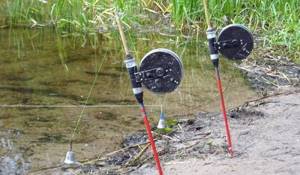
As for bait for bream, here you can experiment a little. Various types of cereals used for bream and flavored one day, green peas, sweet corn or boilies the next, don’t forget about ready-made store-bought options.
In homemade versions, the base is usually pearl barley and millet, and the flavoring is strawberry, honey, anise, and vanilla. In early spring and autumn, it is better to use bait of animal origin, such as bloodworms or maggots.
When it comes to bait, dung worms are the best choice. They are planted in bunches of several pieces. Peas, maggots, mastyrka, and pearl barley are also used. You can also experiment with the bait, fortunately you have enough hooks - you can quickly determine the preferences of the fish.

